Flower-Shaped C-Dots/Co3O4{111} Constructed with Dual-Reaction Centers for Enhancement of Fenton-Like Reaction Activity and Peroxymonosulfate Conversion to Sulfate Radical
Abstract
1. Introduction
2. Results and Discussion
2.1. Characterization of Catalysts
2.2. Catalytic Activity and Stability
2.3. Density Functional Theory (DFT) Calculation
2.4. The Possible Degradation Pathway of OTC and ENR
2.5. Proposed Catalytic Mechanism
3. Materials and Methods
3.1. Chemicals
3.2. Synthesis of Catalysts
3.3. Characterization of Catalysts
3.4. Catalytic Performance
4. Conclusions
Supplementary Materials
Author Contributions
Funding
Institutional Review Board Statement
Informed Consent Statement
Data Availability Statement
Conflicts of Interest
References
- Hu, P.; Long, M. Cobalt-catalyzed sulfate radical-based advanced oxidation: A review on heterogeneous catalysts and applications. Appl. Catal. B Environ. 2016, 181, 103–117. [Google Scholar] [CrossRef]
- Pi, Y.; Ma, L.; Zhao, P.; Cao, Y.; Gao, H.; Wang, C.; Sun, J.; Dong, S.; Li, Q. Facile green synthetic graphene-based Co-Fe Prussian blue analogues as an activator of peroxymonosulfate for the degradation of levofloxacin hydrochloride. J. Colloid Interface Sci. 2018, 526, 18–27. [Google Scholar] [CrossRef] [PubMed]
- Wang, Y.; Liu, C.; Zhang, Y.; Meng, W.; Yu, B.; Pu, S.; Yuan, D.; Qi, F.; Xu, B.; Chu, W. Sulfate radical-based photo-Fenton reaction derived by CuBi2O4 and its composites with α-Bi2O3 under visible light irradiation: Catalyst fabrication, performance and reaction mechanism. Appl. Catal. B Environ. 2018, 235, 264–273. [Google Scholar] [CrossRef]
- Lyu, L.; Zhang, L.; Wang, Q.; Nie, Y.; Hu, C. Enhanced Fenton Catalytic Efficiency of gamma-Cu-Al2O3 by sigma-Cu2+-Ligand Complexes from Aromatic Pollutant Degradation. Environ. Sci. Technol. 2015, 49, 8639–8647. [Google Scholar] [CrossRef] [PubMed]
- Hammouda, S.B.; Zhao, F.; Safaei, Z.; Ramasamy, D.L.; Doshi, B.; Sillanpää, M. Sulfate radical-mediated degradation and mineralization of bisphenol F in neutral medium by the novel magnetic Sr2CoFeO6 double perovskite oxide catalyzed peroxymonosulfate: Influence of co-existing chemicals and UV irradiation. Appl. Catal. B Environ. 2018, 233, 99–111. [Google Scholar] [CrossRef]
- Li, X.; Wang, Z.; Zhang, B.; Rykov, A.I.; Ahmede, M.A.; Wang, J. FexCo3−xO4 nanocages derived from nanoscale metal–organic frameworks for removal of bisphenol A by activation of peroxymonosulfate. Appl. Catal. B Environ. 2016, 181, 788–799. [Google Scholar] [CrossRef]
- Rajeshkhanna, G.; Umeshbabu, E.; Ranga Rao, G. Charge storage, electrocatalytic and sensing activities of nest-like nanostructured Co3O4. J. Colloid Interface Sci. 2017, 487, 20–30. [Google Scholar] [CrossRef]
- Song, K.; Cho, E.; Kang, Y.-M. Morphology and Active-Site Engineering for Stable Round-Trip Efficiency Li–O2 Batteries: A Search for the Most Active Catalytic Site in Co3O4. ACS Catal. 2015, 5, 5116–5122. [Google Scholar] [CrossRef]
- Qin, C.; Hou, B.; Wang, J.; Wang, Q.; Wang, G.; Chen, C.; Jia, L.; Li, D. Crystal-Plane-Dependent Fischer–Tropsch Performance of Cobalt Catalysts. ACS Catal. 2018, 8, 9447–9455. [Google Scholar] [CrossRef]
- Spezzati, G.; Benavidez, A.D.; Delariva, A.T.; Su, Y.; Hensen, E.J.M.; Hofmann, J.P.; Asahinac, S.; Olivier, E.J.; Neethling, J.H.; Miller, J.T. CO oxidation by Pd supported on CeO2(100) and CeO2(111) facets. Appl. Catal. B Environ. 2019, 243, 36–46. [Google Scholar] [CrossRef]
- Xu, S.; Zhu, H.; Cao, W.; Wen, Z.; Wang, J.; François-Xavier, C.P.; Wintgens, T. Cu-Al2O3-g-C3N4 and Cu-Al2O3-C-dots with dual-reaction centres for simultaneous enhancement of Fenton-like catalytic activity and selective H2O2 conversion to hydroxyl radicals. Appl. Catal. B Environ. 2018, 234, 223–233. [Google Scholar] [CrossRef]
- Zubir, N.A.; Yacou, C.; Motuzas, J.; Zhao, X.S.; Diniz Da Costa, J.C. The sacrificial role of graphene oxide in stabilising a Fenton-like catalyst GO-Fe3O4. Chem. Commun. 2015, 51, 9291–9293. [Google Scholar] [CrossRef] [PubMed]
- Xiao, Y.; Liu, S.; Fang, S.; Jia, D.; Su, H.; Zhou, W.; Wiley, J.B.; Li, F. Plum-like and octahedral Co3O4 single crystals on and around carbon nanotubes: Large scale synthesis and formation mechanism. RSC Adv. 2012, 2, 3496. [Google Scholar] [CrossRef]
- Shinde, S.L.; Ishii, S.; Dao, T.D.; Takei, T.; Sugvaneshwar, R.P.; Nanda, K.K.; Nagao, T. Enhanced Solar Light Absorption and Photoelectrochemical Conversion Using TiN Nanoparticle-Incorporated C3N4-C Dot Sheets. ACS Appl. Mater. Interfaces 2018, 10, 2460–2468. [Google Scholar] [CrossRef] [PubMed]
- Zhang, H.; Wu, W.; Li, Y.; Wang, Y.; Zhang, C.; Zhang, W.; Wang, L.; Niu, L. Enhanced photocatalytic degradation of ciprofloxacin using novel C-dot@Nitrogen deficient g-C3N4: Synergistic effect of nitrogen defects and C-dots. Appl. Surf. Sci. 2019, 465, 450–458. [Google Scholar] [CrossRef]
- Wang, L.; Yan, D.; Lyu, L.; Hu, C.; Jiang, N.; Zhang, L. Notable light-free catalytic activity for pollutant destruction over flower-like BiOI microspheres by a dual-reaction-center Fenton-like process. J. Colloid Interface Sci. 2018, 527, 251–259. [Google Scholar] [CrossRef]
- Lu, Y.; Zhan, W.; He, Y.; Wang, Y.; Kong, X.; Kuang, Q. MOF-templated synthesis of porous Co3O4 concave nanocubes with high specific surface area and their gas sensing properties. ACS Appl. Mater. Interfaces 2014, 6, 4186–4195. [Google Scholar] [CrossRef]
- Kang, M.; Kang, M.; Zhou, H.; Wu, D.; Lv, B. Systematic shape evolution of Co3O4 nanocrystals from octahedra to spheres under the influence of C2O42− and PVP. CrystEngComm 2016, 18, 9299–9306. [Google Scholar] [CrossRef]
- Okeyoshi, K.; Shinhama, T.; Budpud, K.; Joshi, G.; Okajima, M.K.; Kaneko, T. Micelle-Mediated Self-Assembly of Microfibers Bridging Millimeter-Scale Gap to Form. Three-Dimensional-Ordered Polysaccharide Membranes. Langmuir 2018, 34, 13965–13970. [Google Scholar]
- Zeng, X.; Wang, Z.; Meng, N.; Mccarthy, D.T.; Deletic, A.; Pan, J.H. Highly dispersed TiO2 nanocrystals and carbon dots on reduced graphene oxide: Ternary nanocomposites for accelerated photocatalytic water disinfection. Appl. Catal. B Environ. 2017, 202, 33–41. [Google Scholar] [CrossRef]
- He, M.; He, M.; Zhang, P.; Xu, S.; Yan, X. Morphology Engineering of Co3O4 Nanoarrays as Free-Standing Catalysts for Lithium-Oxygen Batteries. ACS Appl. Mater. Interfaces 2016, 8, 23713–23720. [Google Scholar] [CrossRef] [PubMed]
- Ren, Y.; Lin, L.; Fan, J.; Yang, Z. Sulfate radicals induced from peroxymonosulfate by magnetic ferrospinel MFe2O4 (M = Co, Cu, Mn, and Zn) as heterogeneous catalysts in the water. Appl. Catal. B Environ. 2015, 165, 572–578. [Google Scholar] [CrossRef]
- Mansournia, M.; Rakhshan, N. Hydrothermal synthesis and tuning of size and morphology of α-Co(OH)2 and α-Co2(OH)3Cl nanostructures as precursors for nanosized Co3O4. Ceram. Int. 2017, 43, 7282–7289. [Google Scholar] [CrossRef]
- Ding, Y.; Chen, M.; Wu, K.; Chen, M.; Sun, L.; Liu, Z.; Shi, Z.; Liu, Q. High-performance peroxidase mimics for rapid colorimetric detection of H2O2 and glucose derived from perylene diimides functionalized Co3O4 nanoparticles. Mater. Sci. Eng. C 2017, 80, 558–565. [Google Scholar] [CrossRef]
- Shang, Z.; Zhan, W.; Sun, M.; Guo, Y. Activity and stability of Co3O4-based catalysts for soot oxidation: The enhanced effect of Bi2O3 on activation and transfer of oxygen. Appl. Catal. B Environ. 2017, 209, 33–44. [Google Scholar] [CrossRef]
- Jácome-Acatitla, G.; Tzompantzi, F.; López-González, R.; García-Mendoza, C.; Alvaro, J.M.; Gómez, R. Photodegradation of sodium naproxen and oxytetracycline hydrochloride in aqueous medium using as photocatalysts Mg-Al calcined hydrotalcites. J. Photochem. Photobiol. A Chem. 2014, 277, 82–89. [Google Scholar] [CrossRef]
- Ezzariai, A.; Riboul, D.; Lacroix, M.Z.; Barret, M.; El Fels, L.; Merlina, G. A pressurized liquid extraction approach followed by standard addition method and UPLC-MS/MS for a fast multiclass determination of antibiotics in a complex matrix. Chemosphere 2018, 211, 893–902. [Google Scholar] [CrossRef]
- Wang, J.; Boyi, Z.; Ruijia, G.; Tian-Shun, S.; Jinping, Y.; Jingjing, X. Degradation characterization and pathway analysis of chlortetracycline and oxytetracycline in a microbial fuel cell. RSC Adv. 2018, 8, 28613–28624. [Google Scholar] [CrossRef]
- Chen, Q.; Wu, S.; Xin, Y. Synthesis of Au–CuS–TiO2 nanobelts photocatalyst for efficient photocatalytic degradation of antibiotic oxytetracycline. Chem. Eng. J. 2016, 302, 377–387. [Google Scholar] [CrossRef]
- Albero, B.; Luis Tadeo, J.; Escario, M.; Miguel, E.; Ana Perez, R. Persistence and availability of veterinary antibiotics in soil and soil-manure systems. Sci. Total Environ. 2018, 643, 1562–1570. [Google Scholar] [CrossRef]
- Matta, M.K.; Chockalingam, A.; Gandhi, A.; Stewart, S.; Xu, L.; Shea, K. LC-MS/MS based quantitation of ciprofloxacin and its application to antimicrobial resistance study in Balb/c mouse plasma, urine, bladder and kidneys. Anal. Methods 2018, 10, 1237–1246. [Google Scholar] [CrossRef]
- Ferrey, M.L.; Coreen Hamilton, M.; Backe, W.J.; Anderson, K.E. Pharmaceuticals and other anthropogenic chemicals in atmospheric particulates and precipitation. Sci. Total Environ. 2018, 612, 1488–1497. [Google Scholar] [CrossRef] [PubMed]
- Chung, H.S.; Lee, Y.J.; Rahman, M.M.; Abd El-Aty, A.M.; Lee, H.S.; Kabir, M.H. Uptake of the veterinary antibiotics chlortetracycline, enrofloxacin, and sulphathiazole from soil by radish. Sci. Total Environ. 2017, 605–606, 322–331. [Google Scholar] [CrossRef] [PubMed]
- Wei, M.; Gao, L.; Li, J.; Fang, J.; Cai, W.; Li, X.; Xu, A. Activation of peroxymonosulfate by graphitic carbon nitride loaded on activated carbon for organic pollutants degradation. J. Hazard. Mater. 2016, 316, 60–68. [Google Scholar] [CrossRef] [PubMed]
- Zhang, J.; Zhao, X.; Wang, Y.; Gong, Y. Peroxymonosulfate-enhanced visible light photocatalytic degradation of bisphenol A by perylene imide-modified g-C3N4. Appl. Catal. B Environ. 2018, 237, 976–985. [Google Scholar] [CrossRef]
- Chen, X.; Oh, W.D.; Hu, Z.T.; Sun, Y.M.; Webster, R.D.; Li, S.Z. Enhancing sulfacetamide degradation by peroxymonosulfate activation with N-doped graphene produced through delicately-controlled nitrogen functionalization via tweaking thermal annealing processes. Appl. Catal. B Environ. 2018, 225, 243–257. [Google Scholar] [CrossRef]
- Gong, C.; Chen, F.; Yang, Q.; Luo, K.; Yao, F.; Wang, S.; Wang, X.; Wu, J.; Li, X.; Wang, D.; et al. Heterogeneous activation of peroxymonosulfate by Fe-Co layered doubled hydroxide for efficient catalytic degradation of Rhoadmine B. Chem. Eng. J. 2017, 321, 222–232. [Google Scholar] [CrossRef]
- Ma, W. One-step synthesis of novel Fe3C@nitrogen-doped carbon nanotubes/graphene nanosheets for catalytic degradation of Bisphenol A in the presence of peroxymonosulfate. Chem. Eng. J. 2019, 356, 1022–1031. [Google Scholar] [CrossRef]
- Wang, Y.; Sun, H.; Ang, H.M.; Moses, O.T.; Wang, S. 3D-hierarchically structured MnO2 for catalytic oxidation of phenol solutions by activation of peroxymonosulfate: Structure dependence and mechanism. Appl. Catal. B Environ. 2015, 164, 159–167. [Google Scholar] [CrossRef]
- Jia, Q.; Jia, Q.; Ramaswamy, N.; Tylus, U.; Strickland, K.; Li, J.; Serov, A. Spectroscopic insights into the nature of active sites in iron–nitrogen–carbon electrocatalysts for oxygen reduction in acid. Nano Energy 2016, 29, 65–82. [Google Scholar] [CrossRef]
- Costentin, C.; Costentin, C.; Drouet, S.; Robert, M.; Saveant, J.M. Turnover numbers, turnover frequencies, and overpotential in molecular catalysis of electrochemical reactions. Cyclic voltammetry and preparative-scale electrolysis. J. Am. Chem. Soc. 2012, 134, 11235–11242. [Google Scholar] [CrossRef] [PubMed]
- Blakemore, J.D.; Blakemore, J.D.; Gray, H.B.; Winkler, J.R.; Müller, A.M. Co3O4 Nanoparticle Water-Oxidation Catalysts Made by Pulsed-Laser Ablation in Liquids. ACS Catal. 2013, 3, 2497–2500. [Google Scholar] [CrossRef]
- Ming, H.; Ma, Z.; Liu, Y.; Pan, K.; Yu, H.; Wang, F.; Kang, Z. Large scale electrochemical synthesis of high quality carbon nanodots and their photocatalytic property. Dalton Trans. 2012, 41, 9526–9531. [Google Scholar] [CrossRef] [PubMed]
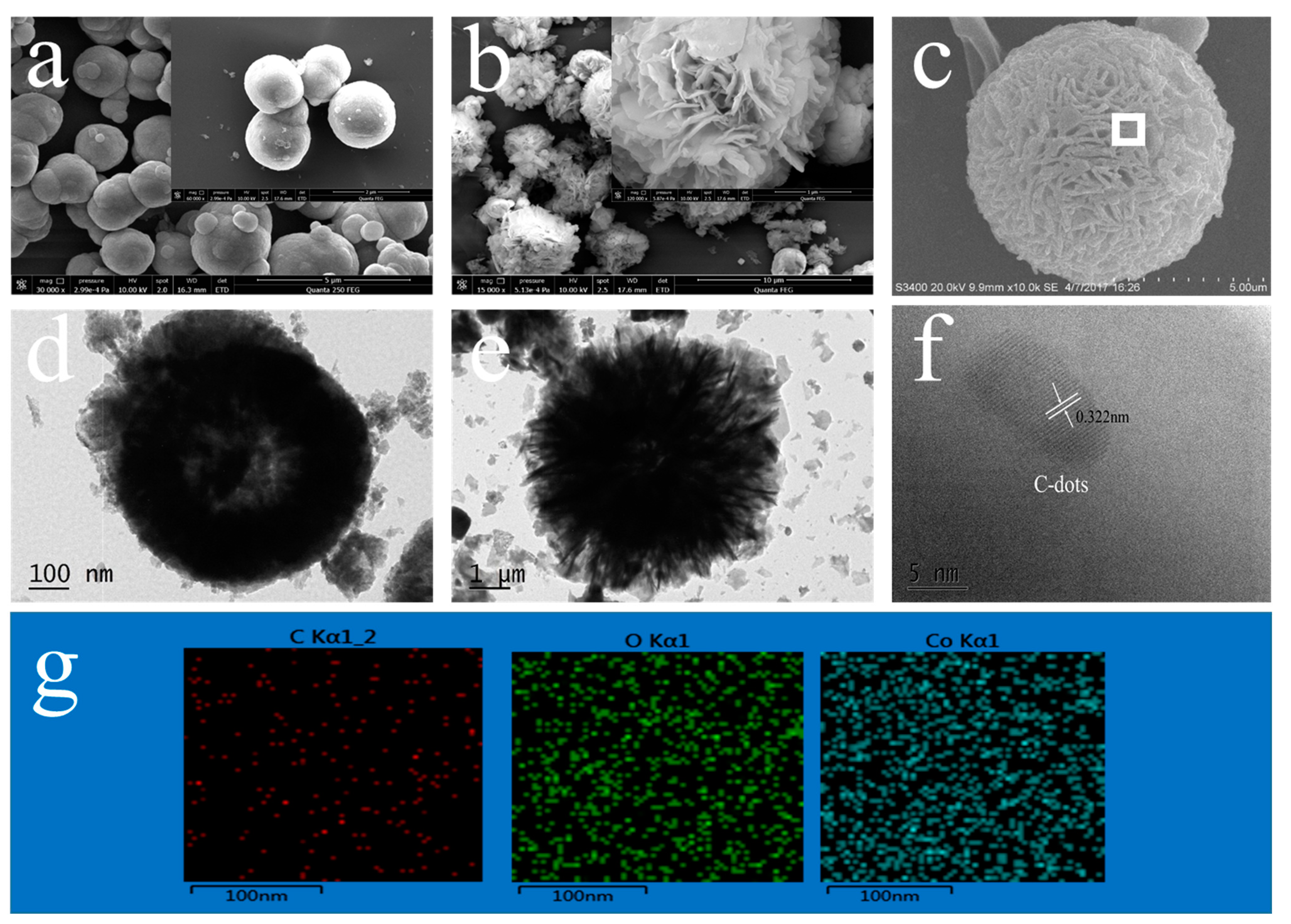
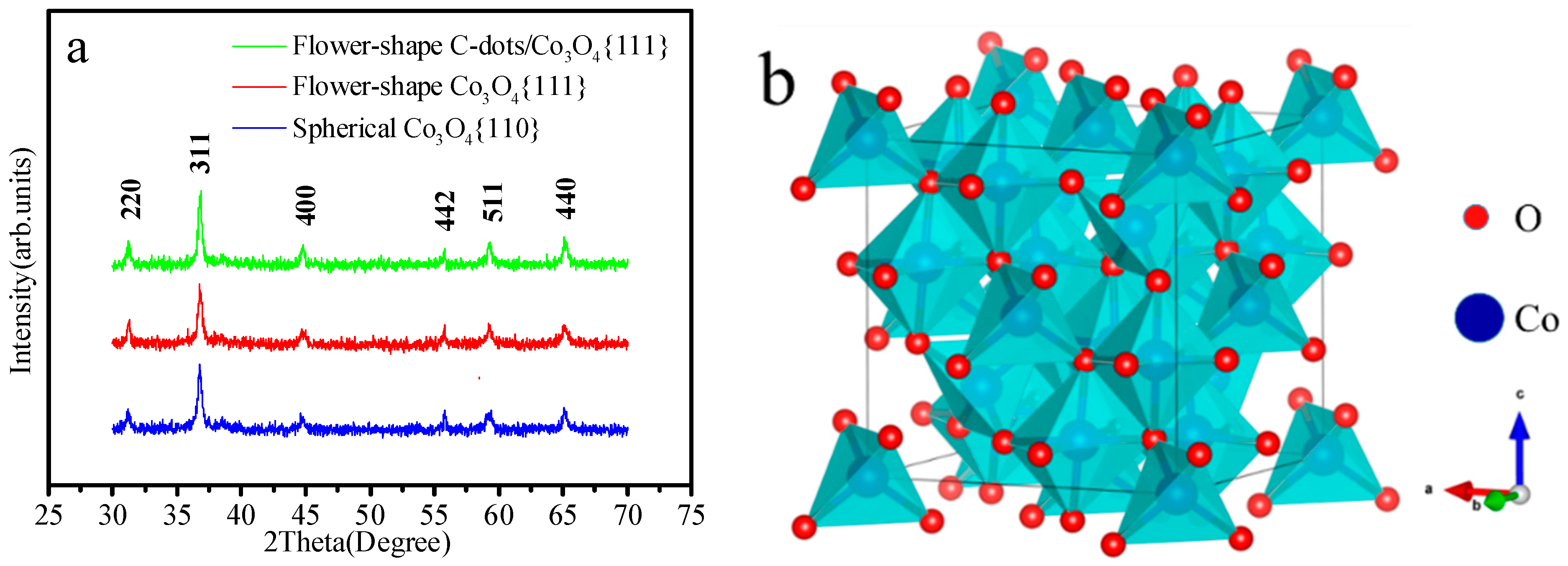



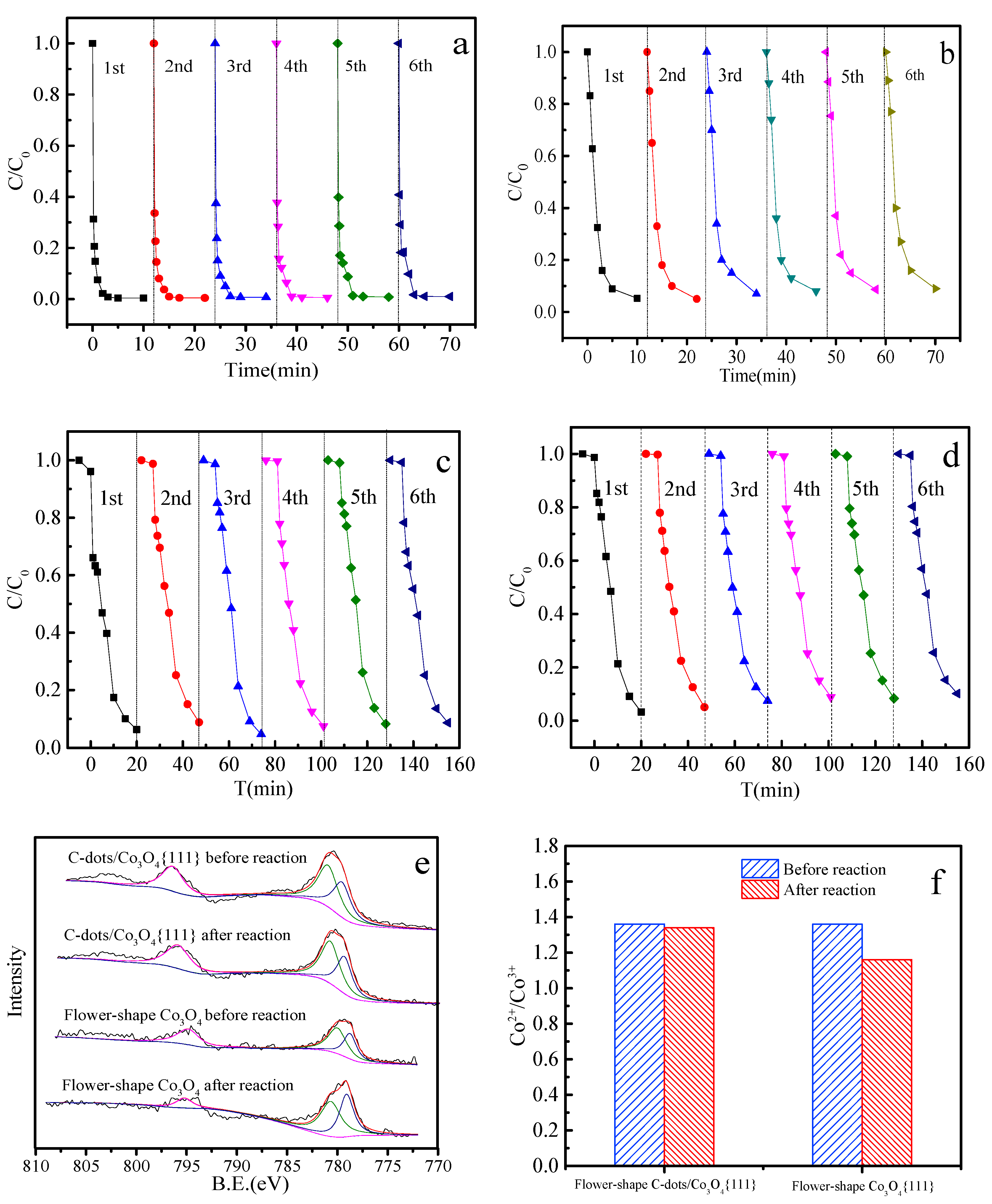
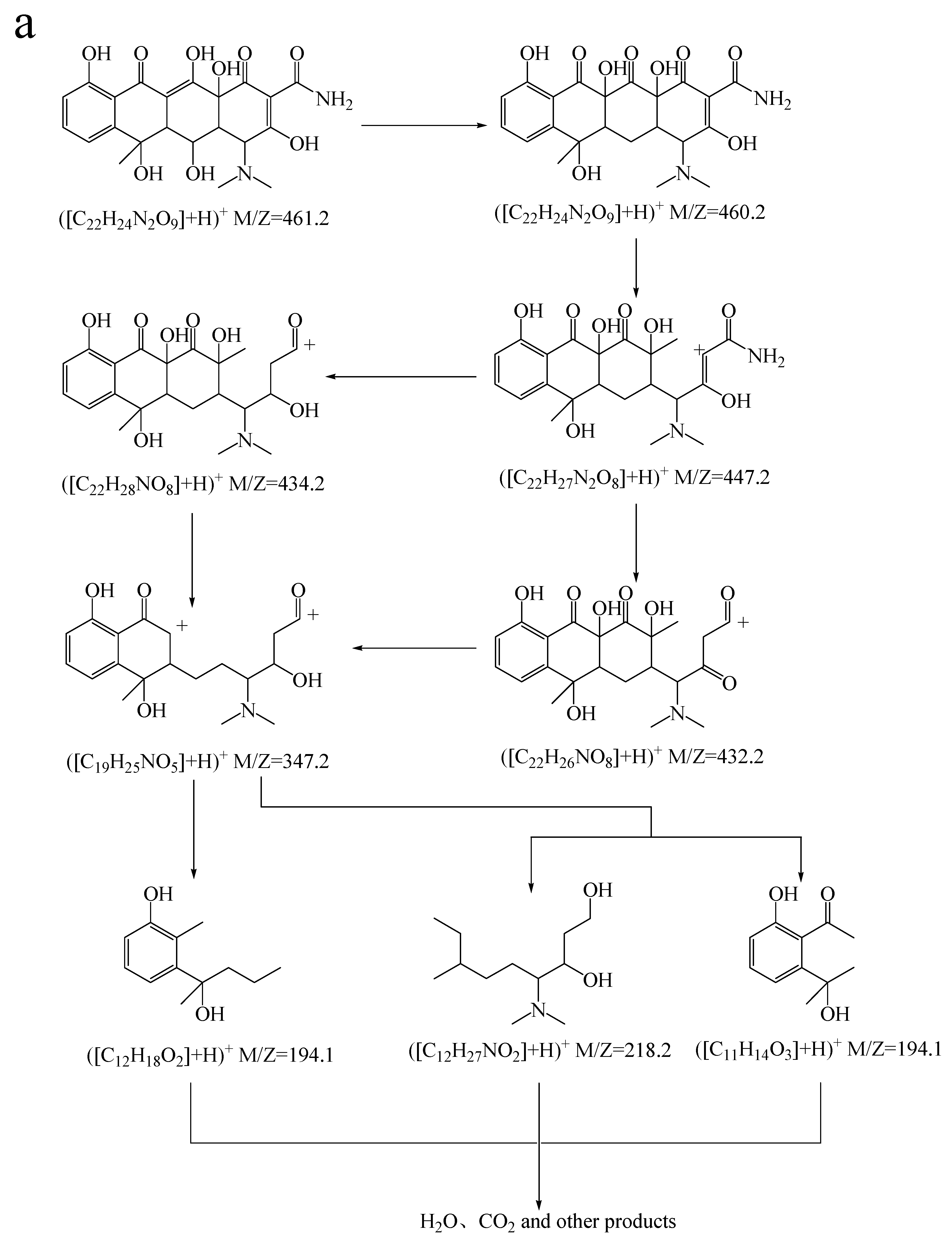

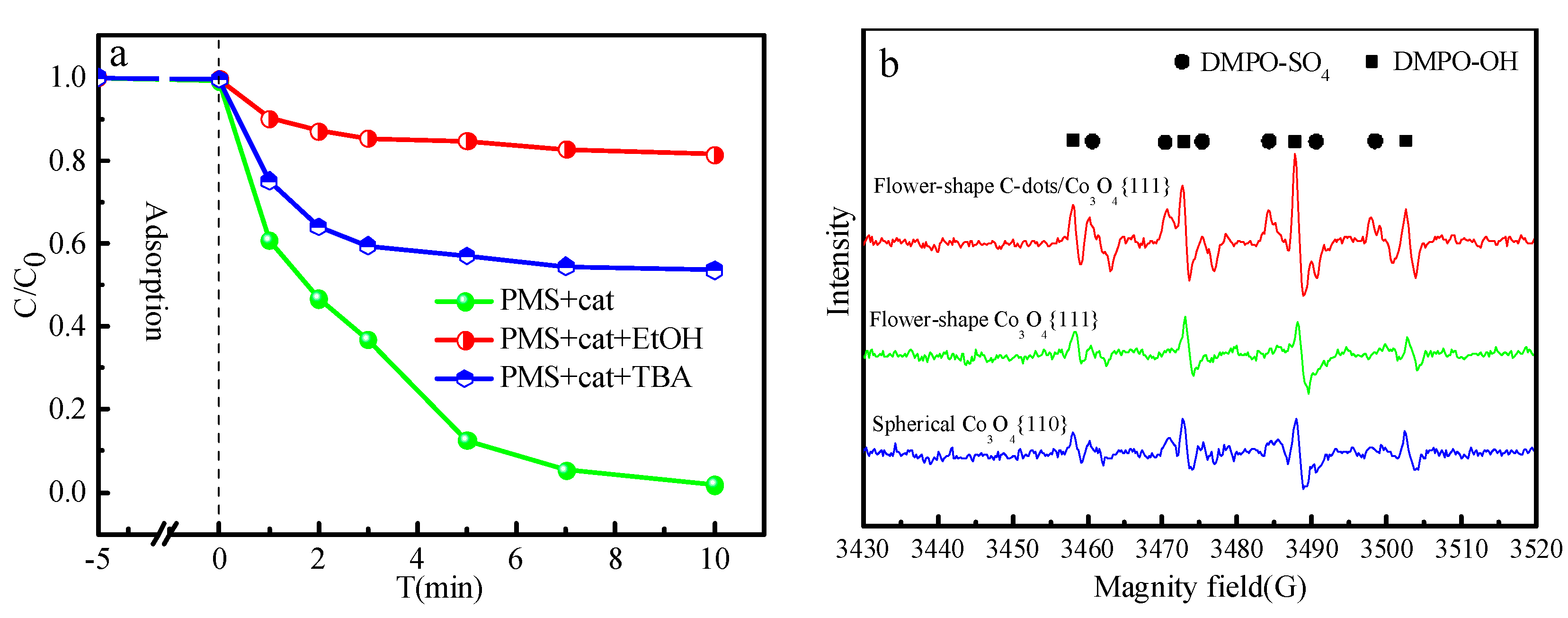

| Catalyst | BET Specific Surface Area (m2/g) | Total Pore Volume (cm3/g) | Average Pore Diameter (Å) |
|---|---|---|---|
| Spherical Co3O4{110} | 35.45 | 0.045 | 66.91 |
| Flower-shaped Co3O4{111} | 83.01 | 0.092 | 76.25 |
| Flower-shaped C-dots/Co3O4{111} | 109.11 | 0.107 | 68.6 |
| Samples | Binding Energy (eV) | Ratios | ||||
|---|---|---|---|---|---|---|
| Co(II) | Co(III) | OC | OL | Co(II)/Co(III) | OC/OL | |
| Spherical Co3O4{110} | 779.8 | 781.1 | 532.1 | 529.1 | 0.77 | 0.659 |
| Flower-shaped Co3O4{111} | 779.6 | 781 | 532 | 529 | 1.36 | 0.635 |
| Flower-shaped C-dots/Co3O4{111} | 779.8 | 781.2 | 532.1 | 529.1 | 1.36 | 0.844 |
| Radical Probo | Reaction Rate Constant (M−1 S−1) | |
|---|---|---|
| SO4−• | OH• | |
| Ethanol (EtOH) | (1.6–7.7) × 107 | (1.2–2.8) × 109 |
| Tert-Butanol (TBA) | (4–9.1) × 105 | (3.8–7.6) × 108 |
Publisher’s Note: MDPI stays neutral with regard to jurisdictional claims in published maps and institutional affiliations. |
© 2021 by the authors. Licensee MDPI, Basel, Switzerland. This article is an open access article distributed under the terms and conditions of the Creative Commons Attribution (CC BY) license (http://creativecommons.org/licenses/by/4.0/).
Share and Cite
Wen, Z.; Zhu, Q.; Zhou, J.; Zhao, S.; Wang, J.; Li, A.; Chen, L.; Bian, W. Flower-Shaped C-Dots/Co3O4{111} Constructed with Dual-Reaction Centers for Enhancement of Fenton-Like Reaction Activity and Peroxymonosulfate Conversion to Sulfate Radical. Catalysts 2021, 11, 135. https://doi.org/10.3390/catal11010135
Wen Z, Zhu Q, Zhou J, Zhao S, Wang J, Li A, Chen L, Bian W. Flower-Shaped C-Dots/Co3O4{111} Constructed with Dual-Reaction Centers for Enhancement of Fenton-Like Reaction Activity and Peroxymonosulfate Conversion to Sulfate Radical. Catalysts. 2021; 11(1):135. https://doi.org/10.3390/catal11010135
Chicago/Turabian StyleWen, Zhibin, Qianqian Zhu, Jiali Zhou, Shudi Zhao, Jinnan Wang, Aimin Li, Lifang Chen, and Weilin Bian. 2021. "Flower-Shaped C-Dots/Co3O4{111} Constructed with Dual-Reaction Centers for Enhancement of Fenton-Like Reaction Activity and Peroxymonosulfate Conversion to Sulfate Radical" Catalysts 11, no. 1: 135. https://doi.org/10.3390/catal11010135
APA StyleWen, Z., Zhu, Q., Zhou, J., Zhao, S., Wang, J., Li, A., Chen, L., & Bian, W. (2021). Flower-Shaped C-Dots/Co3O4{111} Constructed with Dual-Reaction Centers for Enhancement of Fenton-Like Reaction Activity and Peroxymonosulfate Conversion to Sulfate Radical. Catalysts, 11(1), 135. https://doi.org/10.3390/catal11010135






